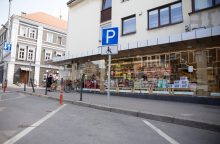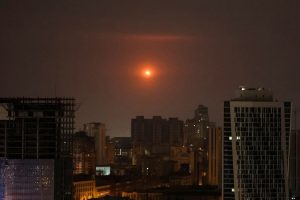KAM: Karaliaučiaus modernizavimas „Iskander“ raketomis - nesuprantamas
SUSIJĘ STRAIPSNIAI
-
 Seimas palengvino neįgaliuosius vežančių automobilių parkavimą
Seimas palengvino neįgaliuosius vežančių automobilių parkavimąNuo lapkričio lengvės neįgaliųjų vairuojamų ar juos vežančių automobilių parkavimas – jų savininkams leista nemokėti mokesčio už stovėjimą savivaldybių nustatytose vietose. ...
-
 Vilniuje kaimynų bendrystę stiprins per dešimt bendruomenių projektų
Vilniuje kaimynų bendrystę stiprins per dešimt bendruomenių projektųSostinė bendruomenių tradicijas kuriančioms ir puoselėjančioms iniciatyvoms šiemet skiria 50 tūkst. Eur. Parama paskirstyta dvylikai kaimynystės ryšius stiprinančių projektų – isi jie dedikuoti vilniečių įtraukimui į kultūrin...
-
 Programa „Vizija – nulis“: pasirinktos 44 priemonės žuvusiųjų skaičiui keliuose mažinti2
Programa „Vizija – nulis“: pasirinktos 44 priemonės žuvusiųjų skaičiui keliuose mažinti2Vilniuje ketvirtadienį pasirašytas tarpinstitucinis memorandumas dėl valstybinės eismo saugumo programos „Vizija – nulis“ priemonių plano įgyvendinimo, kuriuo bus siekiama iki 2030 m. žymiai sumažinti žuvusiųjų skaičių &sca...
-
 I. Šimonytė: „Rheinmetall“ atėjimas į Lietuvą gali būti išnaudojamas gąsdinant dalį visuomenės10
I. Šimonytė: „Rheinmetall“ atėjimas į Lietuvą gali būti išnaudojamas gąsdinant dalį visuomenės10Vokietijos gynybos pramonės atstovei „Rheinmetall“ planuojant įkurti gamyklą Lietuvoje, ministrė pirmininkė Ingrida Šimonytė tikina, kad tam tikros grupės gali išnaudoti šį faktą, kaip dalies visuomenės gąsdinimo įr...
-
 Dezinformacijos grėsmė: kaip pažaboti melagienas
Dezinformacijos grėsmė: kaip pažaboti melagienasLietuviai supranta, kad kasdienėje aplinkoje juos supa ne tik naudinga, bet ir melaginga informacija, tačiau labiausiai paplitę dezinformacijos naratyvai ne vieną vis dar suklaidina. Plačiai pateikiama informacija apie karą ir tarptautinius santykius, sv...
-
 Pasienyje su Baltarusija nefiksuota neteisėtų migrantų
Pasienyje su Baltarusija nefiksuota neteisėtų migrantųLietuvos pasienyje su Baltarusija penktą parą iš eilės nefiksuota bandymų neteisėtai patekti į šalį, ketvirtadienį pranešė Valstybės sienos apsaugos tarnyba (VSAT). ...
-
 Susisiekimo ministerijoje pasirašomas memorandumas dėl žūčių keliuose mažinimo6
Susisiekimo ministerijoje pasirašomas memorandumas dėl žūčių keliuose mažinimo6Ketvirtadienį Susisiekimo ministerijoje pasirašomas žūčių keliuose mažinimui skirtos programos „Vizija–nulis“ programos plano įgyvendinimo memorandumas. ...
-
 Medininkų pasienio kontrolės punkte naktį kilo gaisras: eismas beveik atnaujintas į abi puses9
Medininkų pasienio kontrolės punkte naktį kilo gaisras: eismas beveik atnaujintas į abi puses9Medininkų pasienio kontrolės punkto angare ketvirtadienio naktį kilus gaisrui ir uždarius eismą abiem kryptimis, rytą pasieniečiai skelbia atnaujinę judėjimą į Baltarusiją. ...
-
 Balandžio 18-oji Lietuvoje ir pasaulyje
Balandžio 18-oji Lietuvoje ir pasaulyjeBalandžio 18-oji, ketvirtadienis, 16 savaitė. ...
-
 Incidentas Kauno oro uoste: lėktuvas negalėjo pakilti1
Incidentas Kauno oro uoste: lėktuvas negalėjo pakilti1Kauno oro uoste, viename iš orlaivių išsiskleidus avarinei išlipimo čiuožyklai, buvo atidėtas skrydis į Londoną. ...

















Aaa
Giii
Kęstas
Majoras